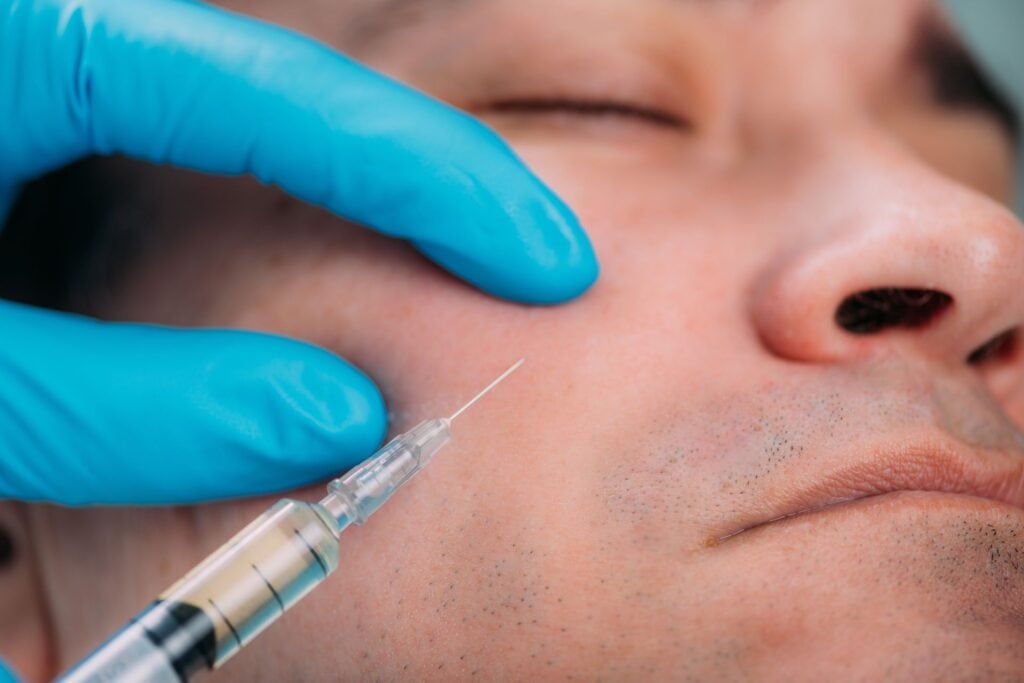Aesthetic medicine is a rapidly growing field, with new developments and treatments emerging on an almost daily basis. Botox is one of the most well-known treatments in aesthetic medicine, used to reduce wrinkles and fine lines in order to maintain a youthful appearance. While Botox has been around for several years now, it continues to be one of the most popular treatments available within aesthetic medicine circles today. This article will discuss the role of Botox in aesthetic medicine, exploring its uses as well as potential risks associated with its use.
Botulinum toxin type A (more commonly referred to as ‘Botox’) is a neurotoxin produced by the bacterium Clostridium botulinum that, when injected into muscles, causes temporary paralysis of those muscles. The effects are mainly cosmetic, smoothing out wrinkles and giving patients a younger-looking face. It can also be used to treat conditions such as excessive sweating or muscular spasms. As such, Botox plays an important role in managing many dermatological issues and improving patient satisfaction.
In addition to reducing facial wrinkles and expression lines, there are other medical uses for Botox including migraine treatment, muscle contracture relief, bladder control therapy and even hyperhidrosis management – all of which have seen great success rates throughout clinical studies conducted over recent decades. Its versatility makes it invaluable to physicians who practice aesthetic medicine and helps them provide excellent care for their patients.
Uses In Aesthetic Medicine
Botox is like a Swiss Army knife of aesthetic medicine. It can be used to treat wrinkles, folds, and creases in the skin caused by aging or sun damage. In addition to its anti-aging properties, it also has cosmetic benefits such as reducing excessive sweating, treating facial asymmetry, lifting brows and cheeks, and diminishing acne scars. Botox injections are quick and relatively painless compared to other treatments. The Botox results usually last between three to four months before requiring touch-ups. Dermatologists recommend that patients receive botox treatments every four to five months for optimal results.
Botox works by temporarily paralyzing targeted muscles beneath the skin’s surface with a small dose of purified protein derived from bacteria. This reduces muscle contractions which helps reduce fine lines and wrinkles while relaxing the face’s expression. When injected into specific areas around the eyes, it can help lift droopy eyebrows and make them appear more youthful. As an added benefit, Botox can relax tension headaches triggered by tight forehead muscles as well as reduce migraines associated with stress and overuse of certain muscles in the head and neck area.
To maximize safety when using Botox for aesthetics purposes, dermatologists often use ultrafine needles which minimize discomfort during injection sessions. Patients should inform their doctor if they have any allergies or previous reactions to medications containing neurotoxin proteins before beginning treatment because these may increase risk of sensitivity or adverse effects after administration of Botox injections. With proper care and maintenance through regular touch-up appointments, you will be able to enjoy lasting results with minimal downtime or disruption to your daily routine. Moving forward into consideration of side effects and risks is important in order to properly assess if this type of treatment is right for you.
Side Effects And Risks
Injections of botox are generally safe and well-tolerated. However, there can be risks associated with the use of this drug when used in aesthetic medicine. These include pain at the injection site, inflammation or redness, infection, swelling, tenderness, bruising, headache and nausea. In rare cases, more serious side effects such as difficulty swallowing or speaking may occur.
It is important to note that botulinum toxin type A does not always completely resolve wrinkles even after repeated injections over time. Additionally, some patients experience a decrease in facial muscle movement due to paralysis caused by botox which may lead to an unnatural appearance. Therefore it is important for physicians to carefully assess each patient prior to treatment and advise them on potential outcomes from injections.
Finally, although results are temporary and will last between three months up to six months depending on the individual’s age and lifestyle habits, long-term consequences could arise if too much of the product is injected into one area excessively over time. To minimize these risks it is essential for individuals seeking aesthetic treatments using botox to seek out experienced practitioners who have had specific training in its usage. With proper precautions taken, botox can provide significant improvements in skin health without causing any harm or lasting damage. Moving forward then we turn our attention towards exploring alternatives to botox as a means of achieving desired cosmetic enhancements.
Alternatives To Botox
As a dermatologist, I often get asked about alternatives to Botox for aesthetic medicine. Aesthetic treatments have become increasingly popular in recent years, and many patients are looking for ways to reduce the signs of aging without resorting to needles or toxins. Fortunately, there are several options that provide effective results with minimal risk.
One such alternative is dermal fillers. These products can be injected into areas where wrinkles form, plumping them up from below while smoothing out the surface. Fillers typically last anywhere from six months to two years before they need to be re-injected, making it a great way to maintain youthful skin over an extended period of time. Hyaluronic acid-based fillers like Juvederm are particularly popular since they act as moisture magnets and temporarily increase collagen production—two key components in slowing down the aging process.
Finally, laser resurfacing has emerged as one of the most successful anti-aging procedures available today. This technique uses precision lasers to penetrate deep beneath the epidermis layer of skin and stimulate natural healing processes that improve texture, tone and elasticity in treated areas; it also helps minimize pore size and even out discoloration due to age spots or sun damage. Laser resurfacing requires little downtime compared with traditional surgical facelifts but offers similar results when done correctly by qualified professionals.
These three methods offer viable solutions for those seeking non-surgical facial rejuvenation without any injections or toxins involved. Each procedure varies slightly in terms of cost and effectiveness so it’s important to research all your options before committing to one solution—but rest assured there are plenty of opportunities available that will help you look younger and more vibrant than ever before!

Frequently Asked Questions
How Much Does Botox Treatment Cost?
Botox has become a popular treatment in aesthetic medicine. It is commonly used to reduce the appearance of wrinkles, crow’s feet and frown lines on the face. The cost of Botox treatments varies depending on several factors:
- Number of areas treated
- Amount of product needed for each area
- Cost per unit
For an accurate price estimate for a Botox treatment, it is important to consult with a qualified dermatologist who specializes in aesthetic treatments such as Botox injections. During your consultation, the doctor can assess your overall goals and customize the treatment plan accordingly. They will also be able to discuss pricing options available based on the specific needs of each patient. For example, some doctors offer discounts if more than one area is being treated or when larger amounts are purchased at once.
In terms of safety, Botox injections have been extensively studied and are considered safe when performed by properly trained medical professionals like dermatologists. In addition, most patients experience minimal side effects and downtime following their procedure so they can resume their normal activities right away after leaving the clinic.
When considering any type of cosmetic procedure, it is essential to choose experienced practitioners that specialize in aesthetics and understand how products work best together for optimal results. Finding this kind of care ensures not only great outcomes but also allows you to rest assured knowing that your safety comes first every step of the way.
How Long Do Botox Results Typically Last?
The longevity of a Botox treatment is an important factor to consider when it comes to the aesthetic benefits of this procedure. The length of time that patients can expect results from their Botox injections depends on several factors, including the amount injected, the area treated and individual response rate. In order to gain an understanding of how long these effects will last, it is necessary to look at current research into its efficacy.
Botulinum toxin (BTX) has been used for decades in both medical and cosmetic treatments as a safe and effective means of reducing wrinkles and providing relief from muscle spasms. Studies have shown that BTX can provide visible results within three days post-injection with peak effect occurring between seven and fourteen days after injection. Additionally, clinical studies suggest that the majority of people who receive BTX treatments experience long lasting improvement when compared with those receiving placebo or no treatment at all.
Research indicates that most individuals can expect effects from BTX to last four months or more; however, there are some cases where effects may not be seen beyond two months after injection. Factors such as dosage size, patient age, lifestyle habits and anatomical location can also affect the duration of results. As a result, dermatologists recommend discussing expectations thoroughly prior to any treatment in order to ensure successful outcomes.
In summary, evidence suggests that BTX offers reliable aesthetic improvements which have proven capable of lasting up to four months or longer depending on various factors related to the individual being treated. It is advisable for those considering Botox injections to consult with a qualified healthcare provider before proceeding so they can make an informed decision about whether this type of treatment might best suit their needs.
Is Botox Safe For Long-Term Use?
Botox has become an increasingly popular form of aesthetic medicine, with many people turning to it for a variety of reasons. With that in mind, the question arises: Is Botox safe for long-term use?
The short answer is yes. Studies have shown that repeated injections of Botox are just as effective and safe as single injections when administered by qualified healthcare practitioners. In fact, some evidence suggests that there may be fewer side effects associated with longer-term use than initial treatments. Additionally, Botox can help reduce wrinkles over time due to its wrinkle relaxing capabilities. However, it should be noted that all procedures involving injectables carry some risk, so patients must weigh the potential risks against the desired results before deciding if this treatment is right for them.
It’s important to note that while Botox is generally considered very safe, those considering it should speak with their doctor about any potential health concerns they may have prior to beginning treatment. This includes informing your doctor about any medications you are currently taking or any allergies you may have since these could interact negatively with the product. Furthermore, it is important to research both the practitioner who will be administering the procedure and the company from whom you buy your products in order to ensure a high level of safety throughout your entire experience—from injection through recovery period afterwards.
In summary, when used correctly and under professional supervision, Botox can provide positive aesthetic results without significant risk to patient health or safety when utilized on a long-term basis. Therefore, individuals looking into this type of treatment should discuss their options thoroughly with a medical expert beforehand in order to make informed decisions based on their own unique circumstances.
Are There Any Age Restrictions For Botox Treatment?
Botox is widely known and used in aesthetic medicine to reduce wrinkles, fine lines, as well as other facial imperfections. But what are the age restrictions for this procedure? Like any medical treatment, it is important to consider all factors before a patient undergoes Botox injections.
Figuratively speaking, many of us can relate to that feeling of wanting to look younger when we start seeing those telltale signs of aging on our faces or bodies. Fortunately, with the help of modern treatments such as Botox, we have more options than ever before. However, it’s essential to ask: Are there any age restrictions for Botox treatment?
As a dermatologist specializing in aesthetics, I’m often asked if there are minimum or maximum ages associated with Botox use. While some medical spas and practitioners may advertise services without considering specific age requirements, this doesn’t mean that they should be disregarded altogether. The truth is that while patients under 18 years old might not technically need parental consent for minor procedures like Botox injections yet still require adult supervision during their appointments; legally only adults aged 18 or over can give informed consent for these types of treatments. This means that regardless of the patient’s physical appearance or maturity level – whether young-looking or mature beyond his/her years – an individual must always meet the legal criteria prior to being treated with Botox injection therapy.
It also needs to be noted that due to both safety concerns and possible side effects from prolonged use (such as headaches and muscle pain), most cosmetic physicians recommend against administering Botox injections until after a person turns 21 years old. Ultimately though, it will depend on each individual case so anyone thinking about undergoing this type of treatment should always consult a board certified dermatologist first who can assess you properly and make sure you are a good candidate for it accordingly.
Is Botox Treatment Painful?
Botox treatment has become an increasingly popular option for many individuals seeking to reduce the signs of aging or enhance their appearance. The procedure is relatively quick, minimally invasive and widely available in clinics around the world. However, one concern that patients may have before undergoing this treatment is whether it will be painful.
To answer this question it is necessary to understand what Botox involves. This cosmetic injectable consists of a purified form of botulinum toxin which temporarily weakens muscles by blocking certain nerve signals. It can then be used to relax facial wrinkles caused by constant muscle contraction such as frown lines and crow’s feet. The effects typically last between 3-6 months after which point the patient would require further injections if they wish to maintain the results.
As far as pain associated with Botox injection goes, different people experience varying levels of discomfort depending on individual factors such as sensitivity to needles, area being treated and dosage administered. Generally speaking however, most patients report only minimal discomfort from the tiny needle pricks during the application process itself, often describing it as no worse than a pin prick or slight sting sensation lasting just a few seconds. Furthermore, local anaesthetic cream or ice packs can be applied prior to treatment in order to numb any potential tenderness at the injection site.
In summary, although there are some physical sensations experienced when receiving Botox injections these tend not to cause significant distress due to their brief duration and mild intensity level; making them tolerable even for those who don’t usually handle needles well. In addition, various techniques exist that can help minimize any minor discomfort felt while administering this aesthetic medication so that users can reap its benefits without having to endure unpleasant side effects along the way.
Conclusion
The effectiveness of Botox in aesthetic medicine is undeniable. It has revolutionized the way wrinkles are treated, providing quick and efficient results with minimal effort. The cost of treatment varies depending on the area being treated, but it can range from a few hundred dollars to thousands for a more extensive procedure. Results typically last between three and four months, making this an affordable choice for people looking to maintain their youthful appearance.
When considering whether or not to use Botox for aesthetic purposes, safety should be taken into account. Although there have been no long-term studies conducted that demonstrate any adverse effects related to prolonged usage of Botox, caution must still be exercised as any medical intervention carries potential risks. Age restrictions also exist; patients must be at least 18 years old before they qualify for Botox treatments.
Despite its reputation as an invasive beauty treatment, those who choose to undergo Botox injections may find that it’s actually quite comfortable. Topical numbing creams can often help reduce discomfort associated with needle insertion while simultaneously reducing the risk of bruising or bleeding afterwards. All things considered, using botulinum toxin (Botox) remains one of the safest and most effective ways to address wrinkles caused by facial expressions as well as other issues affecting aesthetics in cosmetic medicine today.



